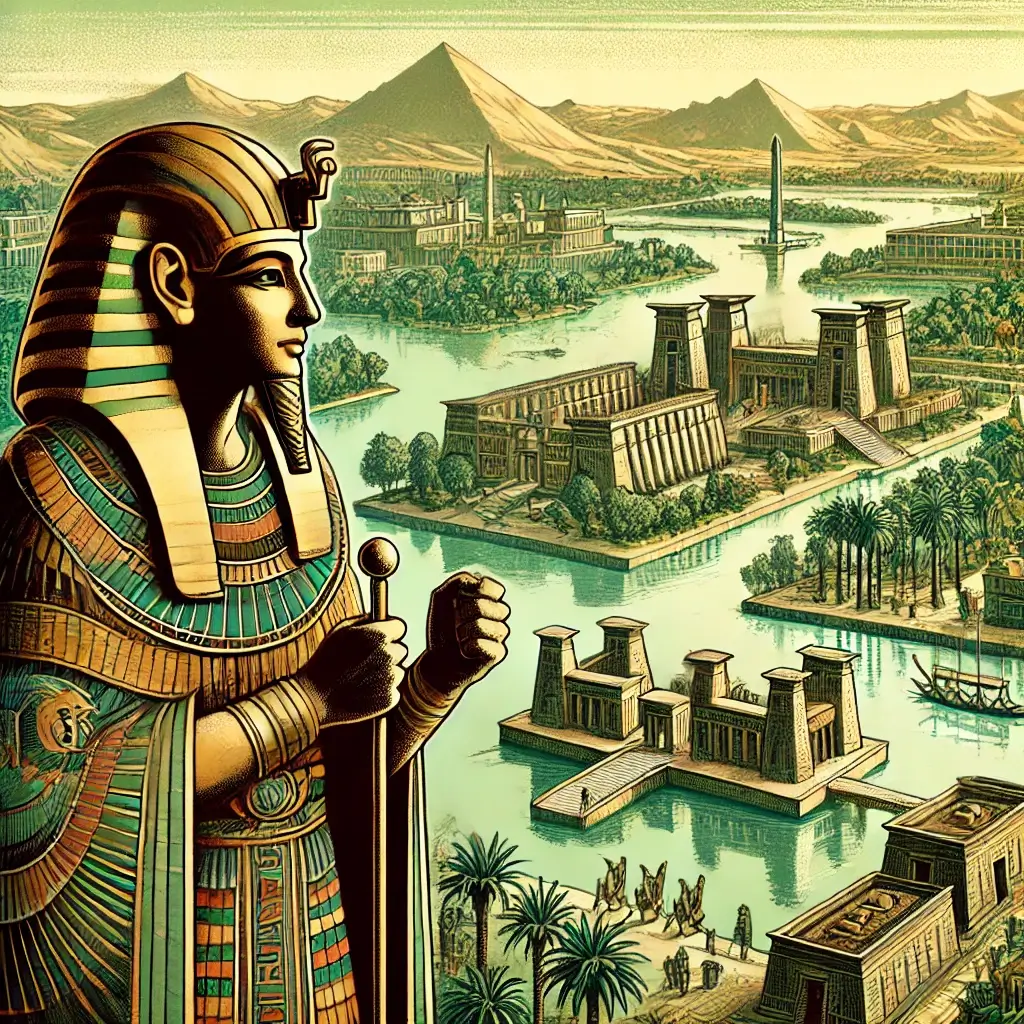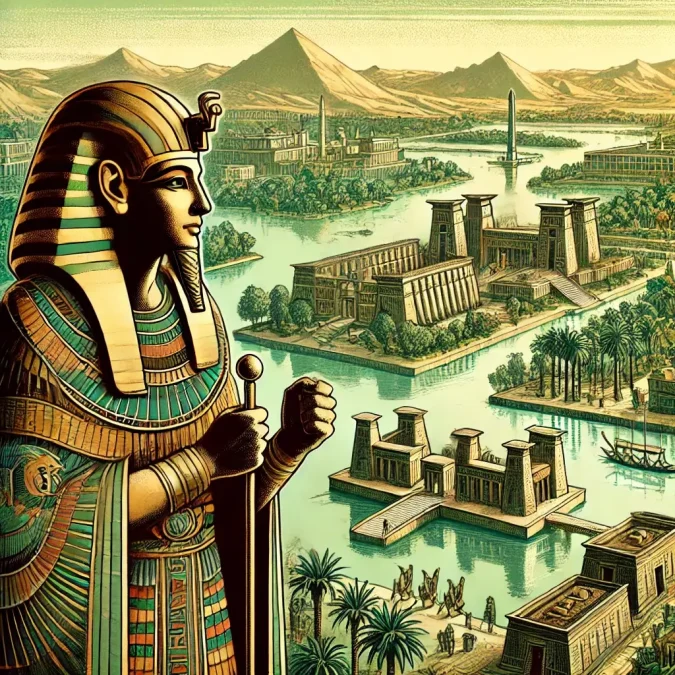
The Fourteenth Dynasty of ancient Egypt (c. 1805–1650 BC) was a series of rulers who reigned during the Second Intermediate Period, a time characterized by political fragmentation, regional power struggles, and the decline of centralized authority. The Fourteenth Dynasty primarily ruled over the Nile Delta region, with its capital located in Xois, a city in the central Delta. The duration of the Fourteenth Dynasty is a topic of debate among historians, with estimates ranging between 75 years (c. 1725–1650 BC) and 155 years (c. 1805–1650 BC). The Egyptian historian Manetho provides valuable insights into the nature of the Fourteenth Dynasty and its rulers.
The Fourteenth Dynasty is significant for its role in shaping the political landscape of the Second Intermediate Period, which was marked by the concurrent rise of the Fifteenth Dynasty, also known as the Hyksos, in Lower Egypt. Despite being a lesser-known period in Egyptian history, the Fourteenth Dynasty is important for understanding the complex dynamics of power and regional control that characterized the Second Intermediate Period. In this article, we will explore the history, rulers, cultural contributions, and challenges faced by the Fourteenth Dynasty, along with the contributions of each pharaoh and their impact on ancient Egyptian civilization.
The Historical Context of the Fourteenth Dynasty
The Second Intermediate Period: A Time of Fragmentation
The Second Intermediate Period of ancient Egypt is often characterized as a time of political fragmentation and regional conflict following the decline of the Middle Kingdom. This period included several overlapping dynasties, including the Thirteenth, Fourteenth, Fifteenth, and Sixteenth Dynasties. The decline of centralized power and the rise of regional rulers led to a complex political landscape in which multiple dynasties competed for control over different parts of Egypt.
The Fourteenth Dynasty primarily ruled over the Nile Delta region, while the Thirteenth Dynasty continued to hold sway over parts of Upper Egypt. The concurrent rise of the Fifteenth Dynasty, also known as the Hyksos, further complicated the political situation, as the Hyksos rulers established their capital in Avaris in the eastern Delta and gradually expanded their influence. The Fourteenth Dynasty was ultimately unable to withstand the growing power of the Hyksos, leading to the eventual collapse of their rule and the consolidation of Hyksos control over Lower Egypt.
The Capital at Xois
According to the Egyptian historian Manetho, the capital of the Fourteenth Dynasty was Xois, a city located in the central Nile Delta. Xois, known in ancient Egyptian as Khasut, was a strategically important location, as it provided access to the fertile lands of the Delta and served as a central hub for trade and administration. The rulers of the Fourteenth Dynasty established their seat of power in Xois in an attempt to maintain control over the Delta region and resist the encroaching influence of other regional powers, including the Hyksos.
The location of Xois in the central Delta allowed the rulers of the Fourteenth Dynasty to maintain access to important trade routes and agricultural resources. However, the political fragmentation of the Second Intermediate Period and the rise of rival dynasties made it difficult for the Fourteenth Dynasty to maintain a stable and unified government. The rulers of the Fourteenth Dynasty faced significant challenges, including economic difficulties, the growing power of regional leaders, and increasing threats from the Hyksos.
The Rulers of the Fourteenth Dynasty
The Fourteenth Dynasty of Egypt is known for its numerous rulers, many of whom had short and relatively obscure reigns. The following section provides a summary of the key rulers of the Fourteenth Dynasty and their contributions to Egyptian history.
King Nehesy
Nehesy is considered one of the most prominent rulers of the Fourteenth Dynasty. His name, which means “The Nubian,” suggests that he may have had Nubian origins, and he is believed to have been the founder of the Fourteenth Dynasty. Nehesy’s reign was marked by efforts to establish control over the Nile Delta and resist the encroaching influence of rival dynasties. He is known for constructing fortifications and administrative buildings in the Delta region, which were intended to strengthen the central authority of the Fourteenth Dynasty.
Nehesy also worked to promote trade and economic development in the Delta. He established trade routes with neighboring regions and sought to secure valuable resources, such as copper and timber. Despite his efforts, Nehesy’s reign was marked by challenges, including economic difficulties and the growing power of the Hyksos in the eastern Delta.
King Sheshi
Sheshi is another significant ruler of the Fourteenth Dynasty, and his reign is notable for the large number of scarabs bearing his name that have been found throughout Egypt and neighboring regions. These scarabs suggest that Sheshi may have had a relatively long reign and that his influence extended beyond the borders of the Delta. Sheshi’s reign was marked by efforts to maintain the stability of the Fourteenth Dynasty and promote trade and diplomacy with neighboring regions.
Sheshi’s scarabs have been found as far away as Canaan, indicating that the Fourteenth Dynasty maintained trade relations with the Levant during his reign. Despite these efforts, the political situation in the Delta remained unstable, and Sheshi faced challenges from rival dynasties, including the Hyksos. His reign ultimately ended with the decline of the Fourteenth Dynasty and the rise of Hyksos power in the Delta.
King Yakbim
Yakbim is a ruler of the Fourteenth Dynasty whose reign is poorly documented. His name suggests that he may have had Semitic origins, which is consistent with the increasing presence of foreign influences in the Nile Delta during the Second Intermediate Period. Yakbim’s reign was marked by efforts to maintain control over the Delta region, but he faced significant challenges from rival powers, including the Hyksos.
The political fragmentation of the Second Intermediate Period made it difficult for Yakbim to maintain a stable and unified government, and his reign was likely marked by ongoing conflicts with regional leaders and rival dynasties. The limited information available about Yakbim’s reign reflects the overall instability of the Fourteenth Dynasty and the challenges faced by its rulers in maintaining control over the Delta.
King Aakheperre
Aakheperre is another ruler of the Fourteenth Dynasty, but like many of his contemporaries, his reign is poorly documented. The rapid succession of rulers during this period made it difficult for any one king to establish a lasting legacy, and Aakheperre’s reign was likely marked by similar challenges to those faced by his predecessors. The limited information available about his reign suggests that he struggled to maintain control over the Delta and resist the growing influence of the Hyksos.
King Yakareb
Yakareb was a ruler of the Fourteenth Dynasty whose name suggests a possible connection to the Levant. His reign is notable for the continued efforts to maintain control over the Delta and resist the encroaching influence of the Hyksos. Yakareb’s reign was marked by economic difficulties, as the central government struggled to maintain control over trade routes and secure valuable resources. The political instability of the Second Intermediate Period made it difficult for Yakareb to establish a lasting legacy, and his reign ultimately ended with the decline of the Fourteenth Dynasty.
King Neferibre
Neferibre is one of the last known rulers of the Fourteenth Dynasty, and his reign marked the beginning of the decline of the dynasty. Neferibre faced significant challenges, including economic difficulties, the growing power of regional leaders, and increasing threats from the Hyksos. His reign was marked by efforts to maintain the central authority of the pharaoh, but the political situation in the Delta remained unstable, and the influence of the Hyksos continued to grow.
Neferibre’s reign ultimately ended with the collapse of the Fourteenth Dynasty and the rise of the Hyksos in Lower Egypt. The Hyksos, who established their capital at Avaris in the eastern Delta, gradually consolidated their power and took control of the entire Delta region, marking the beginning of a new era of foreign rule in Egypt.
Cultural and Political Achievements of the Fourteenth Dynasty
The Struggle for Control of the Nile Delta
One of the defining characteristics of the Fourteenth Dynasty was the struggle for control of the Nile Delta. The rulers of this dynasty faced significant challenges in maintaining a stable and unified government, as the Delta region was home to numerous rival power centers and external threats. The rise of the Hyksos in the eastern Delta further complicated the political situation, as the Hyksos gradually expanded their influence and challenged the authority of the Fourteenth Dynasty.
Despite these challenges, the rulers of the Fourteenth Dynasty worked to establish their authority in the Delta and maintain control over important trade routes and agricultural resources. The capital at Xois served as a central hub for administration and trade, and the rulers of the Fourteenth Dynasty sought to promote economic development and secure valuable resources.
Trade and Diplomacy
The Fourteenth Dynasty is notable for its efforts to promote trade and diplomacy with neighboring regions. The rulers of this dynasty established trade routes with the Levant, Nubia, and other neighboring regions, seeking to secure valuable resources such as copper, timber, and luxury goods. The presence of scarabs bearing the names of Fourteenth Dynasty rulers, such as Sheshi, in regions as far away as Canaan suggests that the Fourteenth Dynasty maintained active trade relations with the Levant during this period.
The emphasis on trade and diplomacy reflects the importance of economic prosperity in maintaining the stability of the Fourteenth Dynasty. The rulers of this dynasty sought to secure valuable resources and maintain control over trade routes, which were essential for the economic well-being of the Delta region. Despite these efforts, the political instability of the Second Intermediate Period made it difficult for the Fourteenth Dynasty to maintain control over its territory and protect its trade interests.
The Rise of the Hyksos and the End of the Fourteenth Dynasty
The decline of the Fourteenth Dynasty was closely linked to the rise of the Hyksos, a foreign people who settled in the eastern Nile Delta and gradually gained power. The Hyksos established their capital at Avaris and began to expand their influence, eventually taking control of the entire Delta region. The rise of the Hyksos marked the end of the Fourteenth Dynasty and the beginning of a new era of foreign rule in Egypt.
The Hyksos brought new technologies and cultural influences to Egypt, including the introduction of the horse and chariot, which would later play a significant role in Egyptian military campaigns during the New Kingdom. The rise of the Hyksos also marked the beginning of the Second Intermediate Period, a time of political fragmentation and foreign domination that would eventually be brought to an end by the Theban rulers of the Seventeenth Dynasty and the reunification of Egypt under the Eighteenth Dynasty.
Conclusion
The Fourteenth Dynasty of ancient Egypt was a period of political fragmentation, regional power struggles, and the gradual decline of centralized authority in the Nile Delta. The rulers of the Fourteenth Dynasty, from Nehesy to Neferibre, faced significant challenges in maintaining control over the Delta region, as they struggled against rival power centers and the growing influence of the Hyksos. Despite these challenges, the Fourteenth Dynasty played an important role in shaping the political landscape of the Second Intermediate Period and setting the stage for the rise of the Hyksos and the eventual reunification of Egypt.
The legacy of the Fourteenth Dynasty is evident in the cultural and political developments that took place during this period, as well as in the continued efforts of its rulers to promote trade, diplomacy, and economic prosperity. The achievements of the Fourteenth Dynasty reflect the resilience of the Egyptian state during a time of political fragmentation and the complex dynamics of power that characterized the Second Intermediate Period.
